You can benefit from these updates since July 2016:
Update sea ship methodology
The update was necessary to adapt to the huge changes that were made in the sea shipping industry within the last years. Additionally, we enlarged the selection of ship types and included the ship types RoRo oversea, RoRo short sea, Ultra large container vessel and two RoRo ferries. Due to the integration of bigger ship types, the update of the ship classification per trade lane and a slower speed on all trade lanes, the emissions could be decreased by up to eighty percent compared to the previous version.
New inland waterway vessel methodology
You can benefit from a new inland waterway methodology that our scientific partners INFRAS and ifeu included. Based on the newest studies and sources, ETW classifies the inland waterway vessels into three types of ships (always as bulk and container carrier):
- Euro ship
- Great engine vessel
- Jowi class
The new Jowi class ships have the lowest emission factors as they have the highest capacity. Overall, the emissions for inland waterway vessels should decrease due to the update.
Update of the electricity mixes
It is important to know the correct electricity mix for the calculation of the energy consumption and emission data. As it is different from country to country, we have decided to implement the national country electricity mixes. This is a big step towards more reliable and comparable calculation results. The year 2013 was used as the base for these values.
Update of the exhaust emissions
The update of the fuel conversion factors for the exhaust emissions, e.g. NOx, NMHC, Particles and SO2, was done on the basis of new factors, which are now more in line with the EN16258.
New GIS-Data layer for Postal Codes
We now provide more than 6,1 million postal codes and can therefore offer a much better world-wide coverage due to our new layer.
Enhancements within the Business Solution
Also the Business Solution were enriched with new enhancements, like new emission factors (year 2015) for sea container calculations with the methodology of the Clean Cargo Working Group (CCWG). The new CCWG emission factors of the year 2015 decreasing the EC and GHG emissions in average by 5-10 percent.
EcoTransIT World additional provides now a factor for operational surcharge of 15 percent, like it was required recently within the CCWG methodology.

